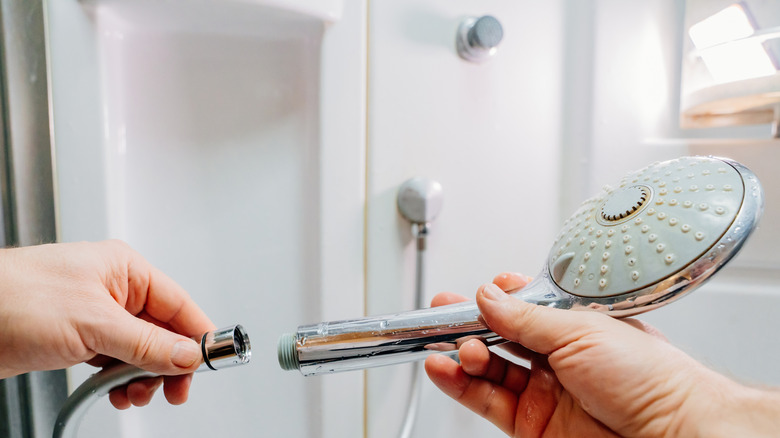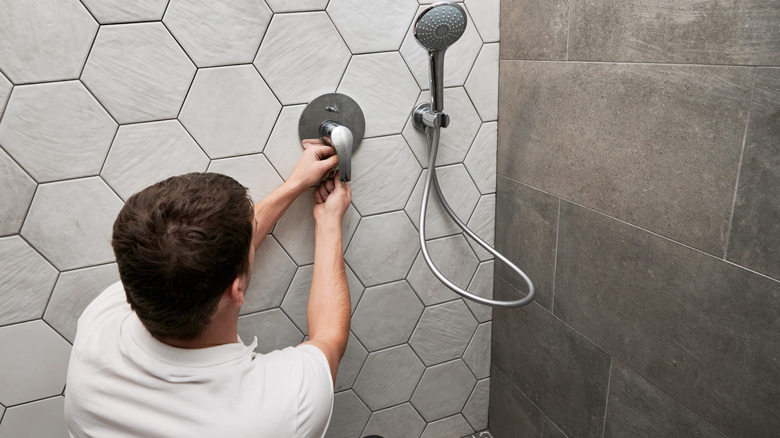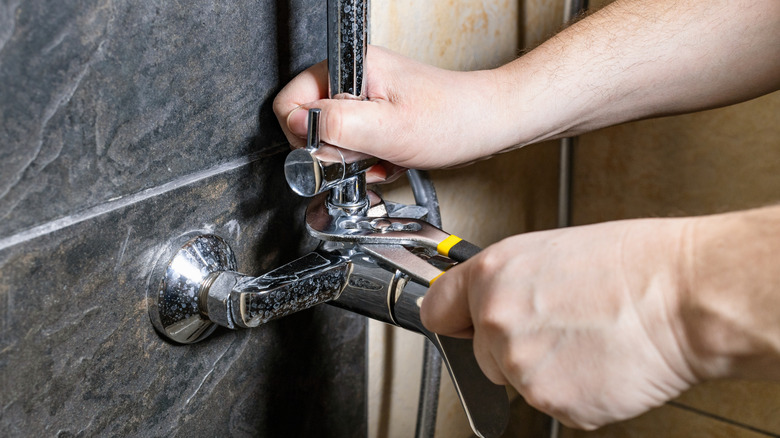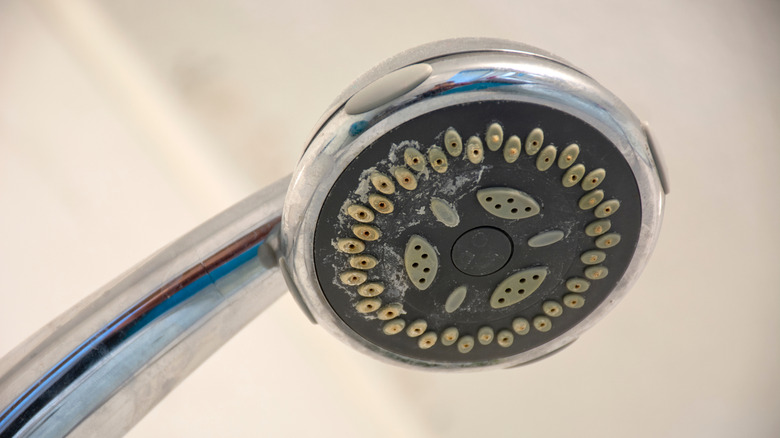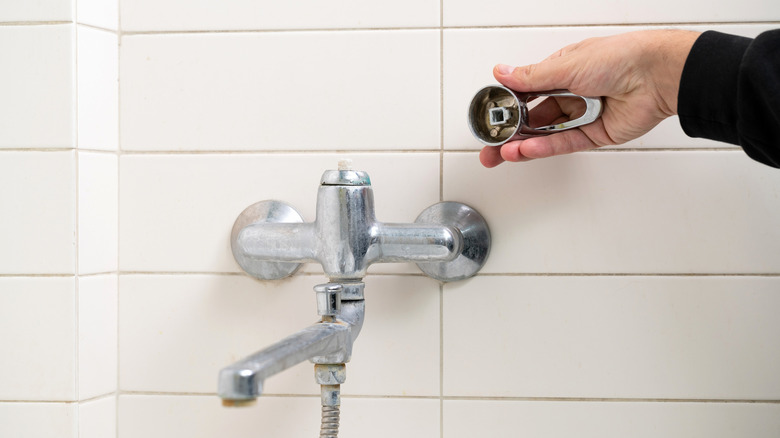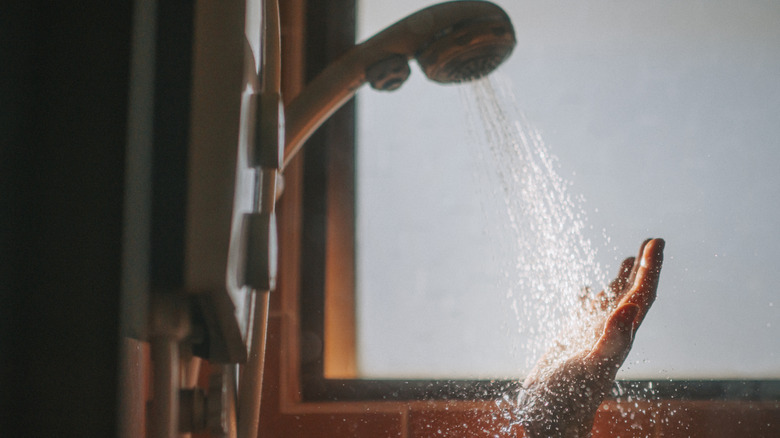5 Reasons Why Your Shower Faucet Is Leaking (And What To Do To Fix It)
Got an annoying and persistent drippy shower faucet that leaks nonstop? It may be a sign that some part of it needs to be fixed. If left unaddressed, it might lead to more significant problems. Instead of ignoring it, let's fix it. The first step in performing a repair is understanding why your shower faucet is leaking in the first place. There are five common reasons your shower faucet might be leaking, including a worn out washer (often the main culprit), deteriorating diverter valves, mineral build up, broken or loose components within the faucet, and excessive water pressure applying strain on the faucet. Don't worry — many of these issues are fairly easy to fix, and you can likely do them yourself.
While a simple drip may seem like a minor inconvenience that disrupts your peaceful shower time, it can be a sign of a more serious issue. Not only that, but ignoring a leaking shower faucet can lead to increased water bills. Yep, that tiny water leak might seem like no big deal, but it can waste a significant amount of water and result in higher utility costs. Continuous leaks can also cause water damage to your bathroom walls, floors, and fixtures, leading to potential mold growth and structural issues. Taking the time to understand and address the cause of your leaking shower faucet can help you maintain a functional and efficient plumbing system, ensuring your shower remains in good condition.
Worn out washer
One of the most common reasons for a leaking shower faucet it a worn out washer. The washer is a small circular component located inside the faucet that helps create a watertight seal when the faucet is turned off. Over time, the flow of water and high pressure can cause the washer to deteriorate, inevitably leading to leaks. This issue can cause an constant drip that eventually results in a spike in your water bill. Additionally, the constant dripping could cause water damage to your bathroom fixtures and promote the growth of mold and mildew, which can be harmful to your health. You'll want to promptly replace the washer in your faucet to avoid all of these issues and prevent them from escalating.
Fortunately, fixing a washer is a pretty simple task that you can most likely handle yourself with a few basic tools. To start, you'll want to turn off the water supply to the shower to prevent any water flow while you work. Then, you'll usually need to remove the faucet handle to access the washer. Depending on the type of faucet, you'll unscrew the handle and remove any decorative caps or covers. Once you have access to the washer, you can remove the old one and put the new one in its place. Washers are inexpensive and you can find them at most hardware stores or online. It's a good idea to take the old washer with you to the store to ensure you get the correct size and type.
Diverter valve
Another common reason for a leaking shower faucet is a deteriorating diverter valve. The diverter valve is a crucial component that directs water flow between the bathtub and the showerhead. The diverter valve can wear out due to constant use and exposure to water, leading to a leaky shower faucet. When this valve deteriorates, it may fail to seal properly, causing water to leak from the tub spout even when the shower is in use. This is problematic because it not only wastes water, but reduces the water pressure in your shower, making it less effective.
With a little bit of patience and some basic tools, you can fix the diverter valve on your own. You can purchase diverter valves at most hardware stores or online. Just make sure you get one that's the right size and correct type for your specific faucet model. To replace the diverter valve, you should turn off the water supply to the shower and then cover the drain so no screws accidentally slip down it. Then, remove the faucet handle and cover plate to access the diverter valve. This typically involves simply unscrewing the handle and plate. Once you remove the diverter valve, you should be able to see the corrosion and deterioration of the valve. Go ahead and replace it with the new one and reassemble everything back in place. This new valve will last around five years on average, but it could perform well for longer if you maintain it.
Mineral buildup
Mineral buildup is another frequent cause of a leaking shower faucet. Hard water, which contains high levels of minerals like calcium and magnesium, can leave deposits inside the faucet. These unsightly mineral deposits can accumulate on the internal components, preventing the faucet from sealing properly and causing it to leak. Hard water buildup can also reduce the water flow, making your shower have less water pressure. Addressing the mineral buildup in your shower faucet will help maintain your plumbing system and the longevity of your faucet.
Luckily, you can tackle this problem with some common household items and a bit of elbow grease. You'll want to turn off the water supply to the shower to avoid any further leakage while you work. Remove the faucet handle and any other parts that are in need of a cleaning. You can then soak these components in a mixture of white vinegar, baking soda, and water, which can dissolve the mineral buildup. If these parts don't detach easily, you can also wrap them in a plastic bag filled with the solution. You'll need the elbow grease when using a brush or rag to scrub away any stubborn deposits. If there's more severe buildup that isn't lifting with this method, you may need to invest in a specialized cleaner. After thoroughly cleaning the parts, rinse them really well and reassemble the faucet. Turn the water supply back on and check for any remaining leaks. This simple cleaning will help to preserve water and keep your bathroom looking squeaky clean.
Broken or loose faucet components
Another reason your shower faucet is leaking could be due to loose or broken components within the faucet itself. The internal parts of the faucet, like screws, washers, and seals, can become loose or break due to regular wear and tear. When these components are not functioning correctly, they can cause water to leak from the faucet. This can become an incessant issue because it not only leads to water wastage but can also result in inconsistent water pressure and temperature control. Loose or broken parts can also make the faucet difficult to operate, leading to further wear and potential damage to other components. If ignored, these issues can become more serious and cause more significant problems that may require a replacement of the entire faucet.
Fixing broken or loose components within your shower faucet is something you can probably do yourself. Turn off the water supply to the shower and then remove the faucet handle and any other parts necessary to reach the internal components. You'll likely have to unscrew the handle and remove any caps or covers. Once you're able to access the internal parts, inspect them for signs of wear, damage, or looseness. Tighten any loose screws or nuts and replace any broken washers or seals. Most of these parts should be fairly inexpensive to buy and easy to find at a nearby hardware store.
High water pressure
High water pressure can be a significant cause of leaks in your plumbing, including your shower faucet. While it might feel luxurious to have a powerful stream of water, excessive water pressure can strain your plumbing system. When the water pressure exceeds the recommended levels (typically between 40 and 80 psi), it can cause various issues. That constant high pressure can wear down normal components of the faucets, like seals and washers, much faster than normal. This not only leads to leaks, but can cause pipes to burst, leading to potentially severe water damage in your home. It might also increase your water bills as more water is being forced through the system than necessary.
One of the first steps you can take to manage the high pressure is to measure the water pressure with a gauge. You can attach the gauge to any faucet to get a reading. If the pressure is above 80 psi, you will need to replace your water pressure regulator. This valve reduces the water pressure coming into your home to a safer level. The gauges and regulators are typically available at your local hardware store and are relatively easy to install. Make sure you follow the manufactures instructions when installing your regulator and install it at the main water line that comes into your home. If you aren't comfortable doing this yourself, you can always hire a professional plumber to do it correctly.
